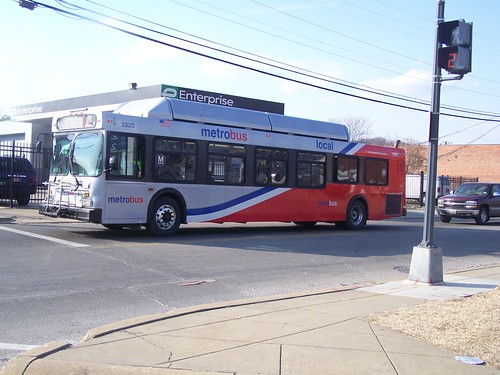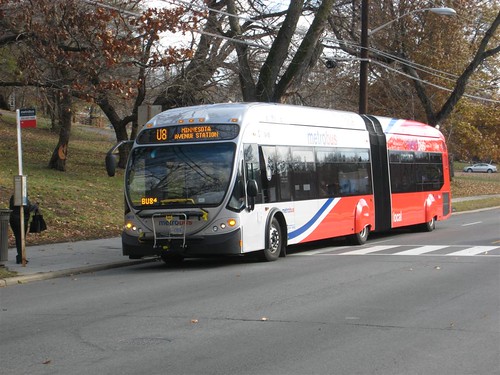An illustration of the space principle as it relates to cars
So today's Post Metro section has a great photo of cars traveling on Leesburg Pike through Tysons Corner, taken by Jahi Chikwendiu.
There are three lanes of traffic. Where the red line is that I have added to the photo is about how many cars in each lane are equal to the capacity of one bus. (I actually understated this number in favor of cars, because the likelihood of these cars having 1 or 2 passengers is pretty low.)
3 buses (40 feet each) or 90 cars.
A 60 foot bus would carry more passengers and "replace" more cars.
40 foot bus (about 60 passengers)

60 foot bus (about 90 passengers)

WMATA subway car (75 feet, up to 150 passengers)

Labels: car culture and automobility, parking and curbside management, transit, transportation planning, urban design/placemaking




9 Comments:
While what you pointed out is absolutely right, more buses on the road can take cars off the road, half of the problem is getting people to take the bus to wherever they want to go.
I don't know how the bus was rendered unattractive, but I do know this--anyone's commute will be longer and more inefficent in a vehicle that stops more often than the rider wants and has to take a route that allows the bus to obtain more in fares than a quicker route.
I think half of the problem with getting people to the bus is having people with cars enjoy rides on the bus. If that could happen, traffic in L.A. could start loosening up.
Very good point. Many trips are conveniently achieved by transit, and many trips are not. But if we could cut half of the trips by car through shifting to transit, that would still make a big difference.
WRT bus, be sure to read this piece (which should have been broken up into separate entries):
http://urbanplacesandspaces.blogspot.com/2012/09/making-bus-service-sexy-and-more.html
I think the biggest problem with mass transit is an economic one. If buses have to be subsidized 70-80%, it will be very hard to expand mass transit. And subways like BART or the Baltimore subway are worse - capital costs in the billions. If riders could pick up 80-90% of the costs, I am sure the demand would be there. Certainly there would be demand for alternatives to driving i-495 or i-695 in rush hour.
I'd be ok with that if motor vehicles picked up 80-90% (including the military costs of maintaining access to overseas oil, which is the root of the Al Qaeda problem faced by the US, etc.) of the costs they imposed on the system too.
It would be actual costs (roads, parking, etc.) + health costs + environmental costs + military/foreign policy costs.
Transit has actual costs, but reduced negative costs from health, environment, and military/foreign policy related costs.
There's also the value capture issue. A lot of the benefits of transit are captured in property values and property taxes, but the revenues are captured by either commercial property owners or the local governments.
Plus paying market rates for parking etc.
As long as cars and sprawl are subsidized in so many ways, transit competes on an unlevel playing field.
Your numbers for the buses are a bit generous. For example the 40-foot New Flyer Low Floor Bus you picture has around 40 seats in most configurations. Getting 20 people to stand, especially on the typical potholed city street, will be a difficult sell. Especially if the route includes any turns.
Because of the physical limits on track geometry, the same cannot be said of the rail transit vehicle (The WMATA Subway Car pictured).
Just using stated capacities. For longer distances, you're right. In the city, for trips of shorter distances, more people are willing to stand.
WRT your general point, and the way that BRT is touted, one of the big reasons that BRT is so successful in South America is because transit dependent riders there are willing to withstand crush loads (rider densities) 2X that of people in North America.
synergy events boston LAUNCHES BOSTON'S TIMELESS BOND GIRL CONTEST 2013 -- Winner to be Revealed at Boston's Fifth Annual Timeless New Years Eve Event at the Marriott Courtyard
Many financial planners are now facing cases in violation of the law so the owners of large companies have difficulty trusting of financial planners. But I found that the financial planner columbia sc is one of the people responsible for our investments.
Very useful post. Makes life of tourists all the more easier and convenient with mobile bus ticket booking. Now Online Bus Booking through mobile is free with i2space Mobile Bus Ticket Booking
Post a Comment
<< Home